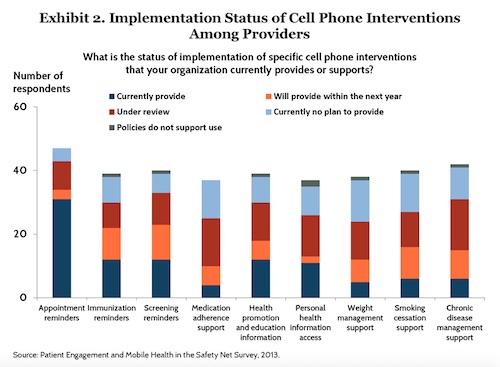A 2013 survey released this week from the Commonwealth Fund shows that use of mobile health interventions at the time was low among urban and rural community health centers and clinics for a variety of reasons. The Commonwealth Fund reached out to nearly 1,000 centers and received responses from 230, of which 181 were included in the final analysis.

"[U]sing technology to promote patient-centered, coordinated care can help make significant advances in improving population health and reducing inefficiencies in care delivery," authors Andrew Broderick and Farshid Haque write in the research brief. "But, as the findings from this survey reveal, providers have not been able to effectively leverage technology tools toward these goals. To fully unlock the potential of technology to improve health care will require an improved understanding of the use of mobile health in patient care, as well as policies that provide funding, technical assistance, and reimbursement and address the issues of informed consent, privacy and security."
Only 27 percent of the survey respondents said they actually used cellphones in care delivery. Of those, 66 percent used them for appointment reminders. Smaller numbers used them for chronic disease management, medication adherence, and smoking cessation, though many said they planned to implement these measures in coming years.
Of those that had interventions, most (62 percent) relied on their EHR to provide them. Less than a quarter (10 out of 42 respondents) partnered with other health organizations to develop interventions and about the same number either built solutions themselves or partnered with a vendor.
The low adoption is especially notable given that 86 percent named patient engagement as a major challenge of their organization, particularly relating to chronic disease management, wellness activities, and preventative care screenings.
Organizations said their top criteria for evaluating a mobile health intervention was appropriateness across diverse patient populations, followed by evidence of improved care quality and evidence of improved cost effectiveness. Few included potential users in design or development of interventions.
The report also speaks to some of the causes of low mobile health intervention adoption among these providers.
"Of the 173 organizations that identified three leading barriers to implementing cell phone interventions, 94 cited a lack of external funding sources and 91 said limited human and technical resources," Broderick and Haque write. "The next-most significant barrier (65 respondents) was the integration of mobile health solutions with electronic health records and other health information technology infrastructure."
















